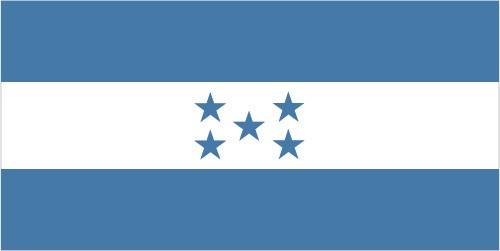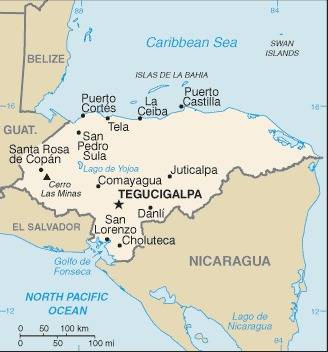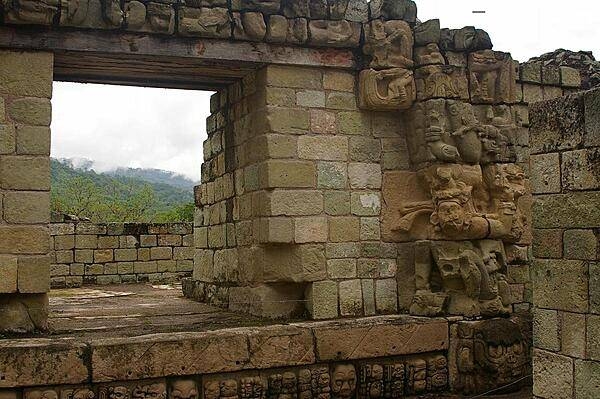23 Honduras

Three equal horizontal bands of cerulean blue (top), white, and cerulean blue, with five cerulean, five-pointed stars arranged in an X pattern centered in the white band. The stars represent the members of the former Federal Republic of Central America: Costa Rica, El Salvador, Guatemala, Honduras, and Nicaragua. The blue bands symbolize the Pacific Ocean and the Caribbean Sea. The white band represents the land between the two bodies of water and the peace and prosperity of its people.
Flag courtesy of the CIA World Factbook

Map courtesy of CIA World Factbook

Entrance way with carvings at a Maya archaeological site at Copán in western Honduras. The site functioned as the political, civil and religious center of the Copán Valley and was composed of a main complex with several secondary complexes. Copán was declared a UNESCO World Heritage Site in 1980.
Photo courtesy of the CIA World Factbook
Government
According to Britannica, since acquiring independence in 1821, Honduras has constitutionally been a democratic, representative, unitary state with power divided among the legislative, executive, and judicial branches. The country’s constitution was rewritten 17 times between the years 1821 and 1982. However, power has often changed hands by violent, undemocratic means. Although the legislature is given the power to pass laws, practically all important legislation is drafted by the president and other members of the executive branch. The National Congress in theory has great authority to check the administrative activities of the president, but only during the period 1925–31, when several cabinet ministers appointed by the president were forced to resign through censure, was such authority effective.
The president, who is head of state and of the government, is elected directly by popular vote for a non renewable term of four years. The single-house National Congress is composed of 128 legislators elected to four-year terms. The major political parties are the Liberal Party of Honduras (Partido Liberal de Honduras) and the National Party (Partido Nacional). All citizens over 18 years of age are permitted to vote.
For purposes of local administration, Honduras is divided into 18 departamentos. Governors are appointed by the president, one for each department, to carry out central government decisions. The departments are divided into municipios (municipalities), which are further partitioned into aldeas (villages, or hamlets). Rural areas are grouped into caseríos (settlements), which are subdivisions of aldeas. Localities may elect a mayor, a legal representative, and a council.
The justices of the Supreme Court are appointed by the president. The Supreme Court exercises centralized control over the lower courts, including the appointment of justices, and has original and exclusive jurisdiction to declare acts of the legislature unconstitutional.
Honduran Civil Aeronautics Agency
The Honduran Civil Aeronautics Agency was created by Legislative Decree No. 121 dated March 14, 1950. It is an entity dedicated to aeronautics, dedicated to the surveillance, organization and promotion of civil aviation. At the time of its creation, a dependency of the Ministry of War, Navy and Aviation is integrated by Decree No. 58 of February 16, 1952, it is transferred to a Ministry of the Secretariat that promotes Public Works, to subsequently become General Directorate of the Ministry of Communications, Public Works and Transportation and currently being the Secretary of Infrastructure and Public Services (INSEP). On October 11, 2014, the General Directorate of Civil Aeronautics was abolished, when Executive Decree PCM-047-2014 was published in the official newspaper La Gaceta, in which the Honduran Agency of Civil Aeronautics was created.
Airspace
SkyVector – Google Maps – ADS-B Exchange
ICAO countries publish an Aeronautical Information Publication (AIP). This document is divided into three parts: General (GEN), En Route (ENR) and Aerodromes (AD). ENR 1.4 details the types of airspace classes they chose to adopt from classes A through G.
COCESNA
The Central American Corporation for Air Navigation Services (COCESNA) is an International Organization for Central American Integration, non-profit and public service, with legal status and financial autonomy, created on February 26, 1960 and governed by a Board of Directors, which it is constituted in its highest collegiate body, which is made up of the representatives of the signatory States of its Constitutive Agreement; established with well-defined objectives and purposes to respond and jointly comply with civil aviation international commitments contracted as signatory countries of the Convention on International Civil Aviation of 1944, known as the Chicago Convention. In that order, COCESNA enjoys the exclusive rights to provide Air Traffic, Aeronautical Telecommunications and Radio Assistance services in the territories of the Member States and other services established in the regional plans that have been entrusted to it by the Contracting Parties. under an international agreement. Its operations are fundamentally based on the Standards and Methods recommended by the ICAO. The adherence to the established norms and the search for excellence constitute COCESNA’s fundamental objectives.
As a result of the notable progress in aviation at the end of the 1950s, especially with the entry into service of jet aircraft, the need to modernize and strengthen the region’s air navigation services was valued, for which, in the month November 1959, a meeting with the Directors was held in Guatemala. Generals of Civil Aeronautics of Central America at that time, within which it was agreed to convene a Diplomatic Conference aimed at establishing a specialized regional organization, with the necessary human and financial resources to meet these modern requirements, as well as to unify and coordinate regional intergovernmental efforts and actions that would benefit the users of these services. Therefore, from February 22 to 26, 1960, the V Conference of Directors of Civil Aeronautics was held in Tegucigalpa, Honduras, signing the guidelines of the Central American Corporation of Air Navigation Services -COCESNA, thus marking the beginning of its existence and operation. Consequently and by virtue of its nature, on February 1, 1961, its Constitutive Agreement was registered with the International Civil Aviation Organization – ICAO and on January 2, 1962 with the United Nations (UN). During the year 1963, COCESNA acquires the official recognition of the States of the Central American isthmus, through decrees and laws that ratified its Constitutive Agreement issued by the Legislative Assemblies of each Member State. Honduras is a member state of COCESNA.
Drone Regulations
Drone Laws include the following:
MANDATORY COMPLIANCE CIRCULAR COC-ATL-002-2018
MANDATORY COMPLIANCE CIRCULAR 2018 Translated into English by Google
Translations
Translations of any materials into English are intended solely as a convenience to the public and are not legally binding. The author has merely attempted to provide a Google translation of the original material to English for convenience. Due to the nuances in translating to a foreign language, several differences may exist so before using for any work or pleasure please have the document translated by a professional service!
DATE: 05/07/18 REGISTRY OF OPERATORS AND LIMITATIONS OF
OPERATION OF AIRCRAFT SYSTEMS
REMOTELY PILOTED (RPAS)
1. INTRODUCTION.
– State the operator’s commitment in writing (describe the statement responsible for the company to guarantee, with his name, address and signature, the commitment to be fulfilled)
– Signature and seal of the operator
– Indicate a brief description of each of the chapters that make up the Document.
Some example:
RPAS: for its acronym in English, Remotely Piloted Aircraft System.
DRONE: Aircraft piloted by remote control that can sustain itself in the atmosphere by reactions of the air other than the reactions of the air against the surface of the Earth.
MO: Operations Manual.
VLOS: Flight in which the RPAS must fly within the visual range of the pilot. No more than 500 meters.
BVLOS: Aircraft piloted beyond the visual range of the pilot. And at most the scope of the station.
NOTAM: for its acronym in English (Notice To Airmen), is a notification system for aviators.
2.1 Amendment and revision system.
– Make a table (symmetrical to Annex 1: Control of changes) to indicate the changes that are done in the manual.
2.2 Documentary control.
– Establish a system of information and general distribution on all aspects related to the MO to all the people who intervene or are affected by the same.
– Define hierarchies and responsibilities (organizational chart) so that the responsibilities of each member in RPAS and operational activities.
– Define the representative of the operator, who will be the most responsible and interlocutor, between pilots, administration, etc.
– Clearly define the categories of the team.
– Operation Manager. (Operator and pilot).
– Flight manager. (Pilot)
– Information Coordinator or Security Supervisor.
– Sensor Operator.
– Responsible for maintenance.
– Auxiliary ground support crew.
– Indicate what type of training (in detail) an RPAS pilot must have.
– Indicate the training and continuing education programs:
– Pilots.
– Information Coordinator or Security Supervisor.
– Controller of sensors.
– Auxiliary ground support crew
– Develop a table with each course code, duration, to which category it should focus, who has received it, when and the evaluation scores of the student.
– Indicate what actions will be taken to always maintain the health of the personnel when maximum level.
– Environmental conditions
– Medicines
– Rest periods
– Indicate breaks, limitations and everything related to compliance with the indicated in the MO in relation to the crew.
– Indicate, in detail, the operations for which, as an operator, the the aeronautical authority in order to obtain permission to operate.
– Indicate how to document everything that is being done in operations and control of said documentation.
IMPORTANT NOTE:
Flight documentation will be kept for at least 5 years. It’s recommended that, in missions with incidents, this information is kept permanently and available.
– Indicate the accident prevention and safety measures that will be adopted in each of the missions or flights.
– Indicate the role and relationship between operators and the Honduran Aeronautical Agency Civil.
9.1 Procedures and instructions to follow for the preparation of the flight.
– Make explicit and in detail the procedures, checklists, flight plans, and any related processes prior to the RPAS operation.
– Detail any process that must or can happen or be invoked during the operation RPAS through standard and emergency procedures, checklists, contingency plans, search and rescue, etc.
IMPORTANT NOTE: In the event of an accident, even if it is the pilot’s fault, if the operation is not reflected in the MO, the responsible is always the operator.
Detail the procedure for the protection of the RPAS and related equipment in the dependencies of the operator, during transfer and during breaks in operations.
– Detail, precisely, the technical characteristics of the aircraft (attaching a technical sheet that contains the same as detailed here) and the station used.
– Detail the takeoff and landing system
– Detail the procedure for the selection and approval of deployment areas and Recovery.
– Define what the flight limitations will be, in a generic way and on the operations.
– General limitations by the Operator.
– Limitations of Operation of the RPAS.
– Define parameters and periodicity of weight and balance of each aircraft
10.6 Equipment calibration criteria and method.
– Define the criteria of operability, minimums and useful life of the equipment, as well as the calibrations that are required in each case.
Define and detail the accident report and its management. Example of what should be in the report:
1. Identification of the event: SERIOUS INCIDENT/ACCIDENT.
2. Manufacturer, model, nationality and registration marks, and serial number of the aircraft.
3. Name of the aircraft owner, operator and lessor, if any, and type of operation.
4. Name of the pilot in command of the aircraft and nationality of the crew and passengers.
5. Date and time (local) that the accident or serious incident occurred.
6. Aircraft position
7. People affected by the accident or serious incident. Injuries and/or deaths.
8. Description of the accident or serious incident, and the damage that the aircraft presents.
– Detail the operator’s policy in the event of an event, incident or accident.
– Detail how to prevent interference with other equipment illicit way.
– Detail which link systems the aircraft/station has to avoid being accidentally intercepted.
– Place here all templates, cards, etc. that were generated throughout the document, as many as necessary. For example:
ANNEX 1 – CHANGE CONTROL
– This annex will indicate all the changes that occur in this user manual operations, who performs it, who supervises it and when.
ANNEX 2 – Maintenance Manual
ANNEX 3 – NOTAM Request
ANNEX-4 – Copy of the Insurance Policy
Advanced Air Mobility (AAM) Regulations & Policies
None found by the author.
However, should you, the reader, happen to stumble across something to the contrary, please email the author at FISHE5CA@erau.edu and you may be mentioned in the ACKNOWLEDGEMENTS section of this book by way of thanks for contributing to this free eBook!
Advanced Air Mobility (AAM) News
None found by the author.
However, should you, the reader, happen to stumble across something to the contrary, please email the author at FISHE5CA@erau.edu and you may be mentioned in the ACKNOWLEDGEMENTS section of this book by way of thanks for contributing to this free eBook!
Short Essay Questions
Scenario-Based Question
You have been hired by a Drone Startup Company. Your boss has immediately assigned this job to you.
They need you to prepare a one-page memo detailing the legalities of using a drone to film Mayan ruins, pictured above.
They need you to mention any national laws and local ordinances.
They specifically want to know what airspace (insert pictures) you will be operating in and whether or not you need an airspace authorization.
Does it matter whether or not you are a citizen of the country?
Lastly, there is a bonus for you if, as you scroll through this chapter, you find any typos or broken links!
Short Essay Questions
- What are the drone categories?
- How is registration addressed?
- How is remote ID addressed?
- What are the model aircraft rules?
- What are the commercial drone rules?
- Are there waivers or exemptions to the rules? If so, for what?
- Would you share a link to an interactive airspace map?
- How is BVLOS addressed?
- How can you fly drones at night?
- How can you fly drones over people?
- Where do you find drone NOTAMs?
- What are the rules for drone maintenance?
- What are the rules for an SMS program?
- What are some unique rules not mentioned above?
- What are the C-UAS rules?
- What are the AAM rules?

